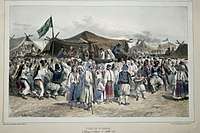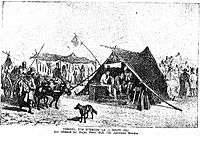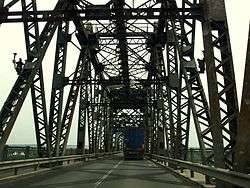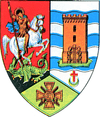Giurgiu
Giurgiu (Romanian pronunciation: [ˈd͡ʒjurd͡ʒju] (![]()
Giurgiu | |
|---|---|
Giurgiu Town Hall | |
 Coat of arms | |
 Giurgiu Location in Romania | |
| Coordinates: 43°54′03″N 25°58′26″E | |
| Country | |
| County | Giurgiu |
| Government | |
| • Mayor | Nicolae Barbu[1] (PSD) |
| Area | 46.94 km2 (18.12 sq mi) |
| Population (2011)[2] | 61,353 |
| • Density | 1,300/km2 (3,400/sq mi) |
| Time zone | EET/EEST (UTC+2/+3) |
| Vehicle reg. | GR |
| Website | www |

The Giurgiu-Ruse Friendship Bridge, in the shared Bulgarian-Romanian section of the Danube, crosses the river in the outskirts of the city.
History


The area around Giurgiu was densely populated at the time of the Dacians (1st century BC) as archeological evidence shows, and Burebista's capital was in this area (it is thought to be in Popeşti on the Argeş River). During Roman times this was the site of Theodorapolis, a city built by the Roman emperor Justinian (483-565).
The city of Giurgiu was probably established in the 14th century as a port on the Danube by the Genoese merchant adventurers, who established a bank and traded in silks and velvets.
One theory is that they called the city after the patron saint of Genoa, San Giorgio (St George), however Nicolae Iorga disputes this theory, arguing that Giurgiu is just an old Romanian form of George.[3]
It was first mentioned in Codex Latinus Parisinus in 1395, during the reign of Mircea I of Wallachia, and was conquered by the Ottomans in 1420 as a way to control the Danube traffic. The Ottomans named the city Yergöğü, as if from yer 'earth' + gök 'sky,' but the name was probably given because of the similarity between the pronunciations of "(San) Giorgio" and "Yergöğü".
As a fortified city, Giurgiu figured often in the wars for the conquest of the lower Danube. It was the site of the October 1595 Battle of Giurgiu, and figured in the struggle of Michael the Brave (1593–1601) against the Turks and in the later Russo-Turkish War (1787-1792). It was burned in 1659. In 1771, the Ottomans built the historic Giurgiu Clocktower as a surveillance tower for Danube traffic. In 1829, its fortifications were finally razed, the only defence left being a castle on the island of Slobozia, connected to the shore by a bridge.
In 1952–1954, during the Communist regime, the USSR helped build the bridge between Giurgiu and Ruse, The Friendship Bridge, a bridge on the Danube linking Romania and Bulgaria.
Demographics
| Historical population | ||
|---|---|---|
| Year | Pop. | ±% |
| 1900 | 13,977 | — |
| 1912 | 20,629 | +47.6% |
| 1930 | 31,016 | +50.4% |
| 1941 | 26,551 | −14.4% |
| 1948 | 30,197 | +13.7% |
| 1956 | 32,613 | +8.0% |
| 1966 | 39,199 | +20.2% |
| 1977 | 51,544 | +31.5% |
| 1992 | 74,191 | +43.9% |
| 2002 | 69,587 | −6.2% |
| 2011 | 54,655 | −21.5% |
| Source: Census data, 1930–1948.[4] | ||
According to the 2011 census, Giurgiu has a population of 54,655.
Notable natives
- Constantin Artachino (1870-1954), painter
- Ioan A. Bassarabescu (1870–1952), writer
- Nicolae Dărăscu (1883-1959), painter
- Toma Ghițulescu (1902–1983), politician and Olympic bobsledder
- Emil Gulian (1907–1942), poet
- Gino Iorgulescu (b. 1956), former Romanian football international
- Dumitru Iuca (1882–1940), politician
- Mihail Manicatide (1867-1954), paediatric physician
- Mihaela Mihai (b. 1946), singer
- Theodor Anton Neagu (b. 1932), palaeontologist
- Miron Nicolescu (1903-1975), mathematician
- Eugenia Popescu-Județ (1925–2011), dancer
- Paraskev Stoyanov (1876–1940), Bulgarian physicist and surgeon
- Eugen Șerbănescu (b. 1952), playwright
- Constantin Teașcă (1922–1996), football coach and writer
- Maria Teohari (1885–1975), first woman astronomer of Romania
- Alexandru Vianu (1903–1936), writer and translator
- Tudor Vianu (1898–1964), literary critic, art critic, poet, philosopher, academic and translator
- Ion Vinea (1895–1964), poet, novel, journalist, literary theorist and political figure
- Vasil Zlatarov (1869–1932), Bulgarian aviation pioneer
International relations
See also
- FC Astra Giurgiu, the city's professional football club
References
- "Results of the 2016 local elections". Central Electoral Bureau. Retrieved 3 April 2020.
- "Populaţia stabilă pe judeţe, municipii, oraşe şi localităti componenete la RPL_2011" (in Romanian). National Institute of Statistics. Retrieved 4 February 2014.
- Iorga, Nicolae (1928). Istoria Românilor prin călători [History of Romanians through travellers] (in Romanian). Bucharest: Casa Școalelor. p. 18.
- Populatia RPR la 25 ianuarie 1948, p. 14
- "МЕЖДУНАРОДНО СЪТРУДНИЧЕСТВО НА ОБЩИНА РУСЕ - Побратимени градове". Община Русе [Municipality Ruse] (in Bulgarian). Archived from the original on 2013-08-05. Retrieved 2013-08-12.
External links
![]()

